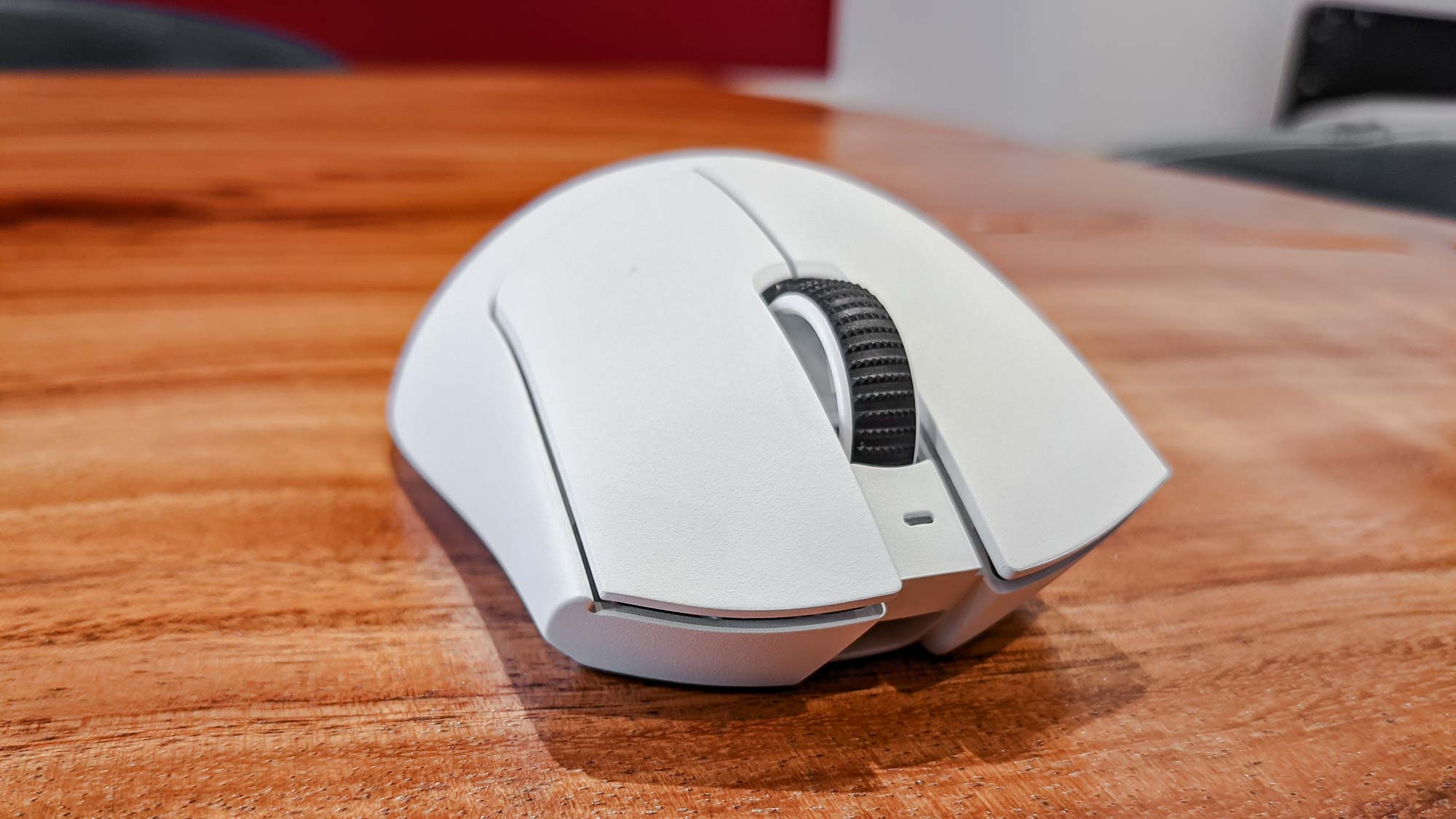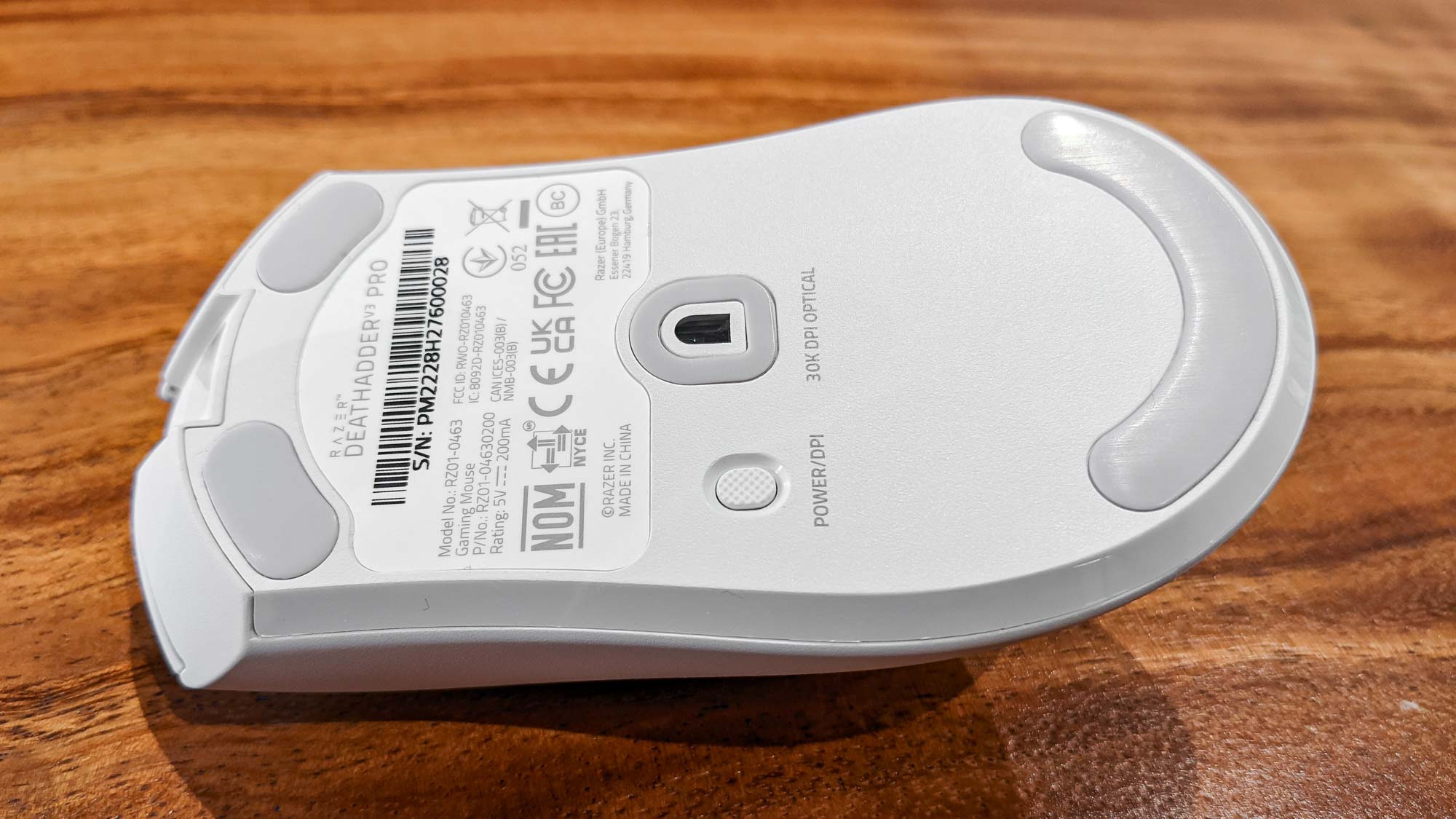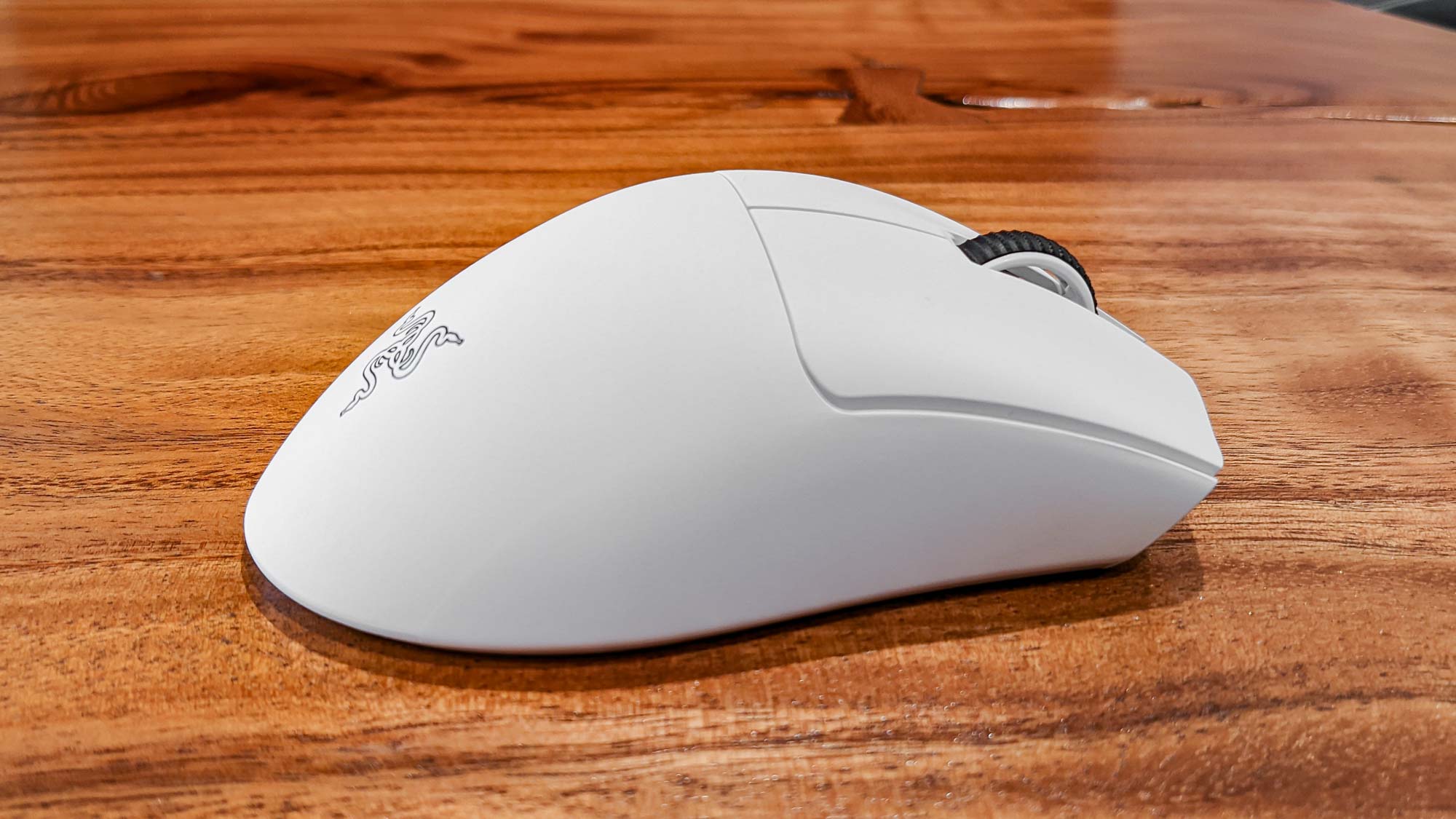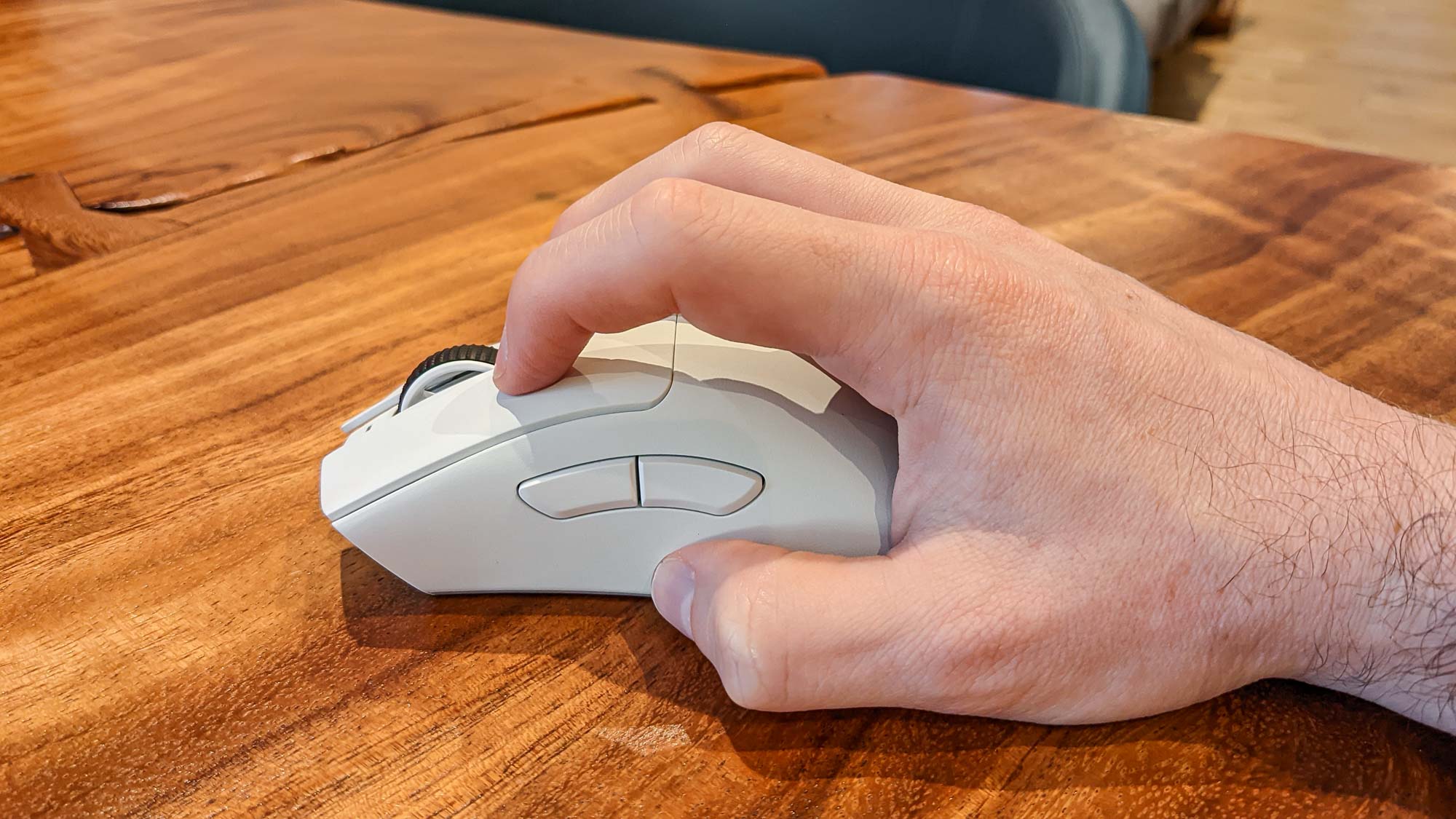Tom's Guide Verdict
The Razer DeathAdder V3 Pro is one of the lightest wireless gaming mice on the market, which comes with a unique set of benefits and drawbacks.
Pros
- +
Super lightweight design
- +
High-quality sensor
- +
Straightforward functionality
Cons
- -
Insubstantial feel
- -
Uncomfortable grip
- -
Offers too little for the price
Why you can trust Tom's Guide
Max DPI: 30,000
Buttons: 5
Size: 5.0 x 2.7 x 1.7 inches
Weight: 2.2 ounces
The Razer DeathAdder V3 Pro is a fine example of a good idea, taken too far. At a mere 2.2 ounces, the DeathAdder V3 Pro is in the running for the lightest wireless gaming mouse on the market. But unlike its more compact brethren, the DeathAdder V3 Pro feels unwieldy and insubstantial, as though it were just a hollow replica rather than a complex gaming device. While you can always lower the dots-per-inch (DPI) sensitivity to compensate, if you pick up this mouse, you’ll have to learn to game with a light touch.
For a $150 mouse, the DeathAdder V3 Pro is also surprisingly bare-bones. It has no Bluetooth functionality, no RGB lighting and only two extra buttons. The design also isn’t nearly as comfortable as that of the Razer DeathAdder V2.
On the other hand, the DeathAdder V3 Pro’s weight is impressive in and of itself, as is the fact that Razer spread that weight across a standard-sized gaming mouse chassis. The fact that the mouse has absolutely no extraneous features might also be a selling point for esports aficionados, who want as little distance between themselves and their games as possible. Still, the DeathAdder V3 Pro has too many caveats, and too niche an audience, to be a strong contender for the best gaming mouse. Read on for our full Razer DeathAdder V3 review.
Razer DeathAdder V3 Pro review: Design
The Razer DeathAdder V3 Pro resembles the DeathAdder V2, although there are subtle differences that longtime fans will most likely notice. The V3 Pro has fewer buttons than the V2, as well as a slightly lower profile and a much lighter weight (2.2 ounces vs. 3.1 ounces). While the DeathAdder V2 has two extra face buttons, the V3 Pro keeps things simple: a left button, a right button, a clickable scroll wheel and two thumb buttons.

On the bottom of the mouse, there’s a power/DPI button, which is much more of an inconvenience than I thought it would be. While having the DPI button on the bottom of the mouse isn’t unheard of, most mice don’t look or feel like the DeathAdder V3 Pro. The device is incredibly light, but has the same size and shape as a regular gaming mouse. As such, the peripheral feels insubstantial, as though there’s nothing at all inside of it. The way the mouse looks does not correspond to the way the mouse feels. Adjusting DPI helps offset this unusual design decision, which is why relegating the DPI button to the bottom of the mouse feels counterintuitive.

Of course, you can reprogram the DPI button, but then you’ll be sacrificing one of the valuable face or thumb buttons.
While the DeathAdder V3 Pro’s weight is its biggest selling point, it’s also one of the mouse’s greatest weaknesses. I never felt like I had good control over where the mouse was, or where it was going, even when I purposely lowered the DPI. Esports aficionados may find something to like here, especially since most lightweight mice tend to be much smaller, which isn’t comfortable for players with large hands. But for everyday gaming, a middle-weight mouse — or a lightweight mouse with a smaller profile — may be more comfortable.
Get instant access to breaking news, the hottest reviews, great deals and helpful tips.
Razer DeathAdder V3 Pro review: Features
I’m of two minds about the Razer DeathAdder V3 Pro’s extra features. To be clear, the device doesn’t have that many. Unlike similar high-end wireless gaming mice, including the Razer DeathAdder V2 Pro and the Corsair Dark Core RGB Pro SE, the DeathAdder V3 doesn’t support Bluetooth, inherently limiting the number of systems it can work with. There’s no RGB lighting, either. You could argue that these features aren’t strictly necessary in a high-end esports mouse, and there is some merit to that argument. But for a staggering $150, the DeathAdder V3 Pro feels like it should come with some bell or whistle apart from its lightweight design.

If you do want to modify the mouse’s options, you can use the competent Razer Synapse software. Here, you can adjust the DPI (up to 30,000 — which you’ll never need, but high DPI is often the mark of a good sensor), reprogram buttons, change the polling rate and set up profiles for individual games and apps. You can also calibrate the mouse to match the surface it’s on, which is admittedly a helpful feature for both casual and competitive players.
Razer DeathAdder V3 Pro review: Performance
From a technical perspective, the Razer DeathAdder V3 Pro performed beautifully in my tests. I ran it through Age of Empires IV, Doom Eternal, Cyberpunk 2077 and Final Fantasy XIV, and found that the mouse parsed my commands quickly and accurately each time. I paid special attention to Age of Empires IV, where moving my cursor around the map, selecting groups of villagers and soldiers, positioning buildings and clicking on enemies has to be perfect — especially for players of a more competitive bent. The DeathAdder V3 had satisfying clicks and perfect response time across the board.

The issue, however, was that the mouse tended to go all over the place, even when I turned the DPI down. The learning curve for a 2.2-ounce mouse that resembles a 4-ounce mouse is high, as it turns out. Especially in Final Fantasy XIV, I constantly overshot what I was trying to click on, leading to the occasional disaster in a multiplayer dungeon run. The big, sweeping movements that you get with such a light mouse feel exhausting after a while, and more than once, I wished that the mouse had tunable weights. Even just a little more heft would have gone a long way.
Razer DeathAdder V3 Pro review: Verdict
While the Razer DeathAdder V3 Pro may be exactly what a small subset of esports players are looking for, I have a much harder time recommending it to the average PC gamer. The design and the weight don’t match, and it leads to a jarring, imprecise experience that just doesn’t feel comfortable for most games.
If you want a wireless DeathAdder, the DeathAdder V2 Pro is the way to go. If you want an ultra-lightweight wireless esports mouse, I would personally go with the Logitech G Pro X Superlight, which also weighs 2.2 ounces and costs $150, but seems to distribute the weight a little better. The DeathAdder V3 Pro is worth considering, but ultimately, it’s not going to be for everyone.

Marshall Honorof was a senior editor for Tom's Guide, overseeing the site's coverage of gaming hardware and software. He comes from a science writing background, having studied paleomammalogy, biological anthropology, and the history of science and technology. After hours, you can find him practicing taekwondo or doing deep dives on classic sci-fi.

